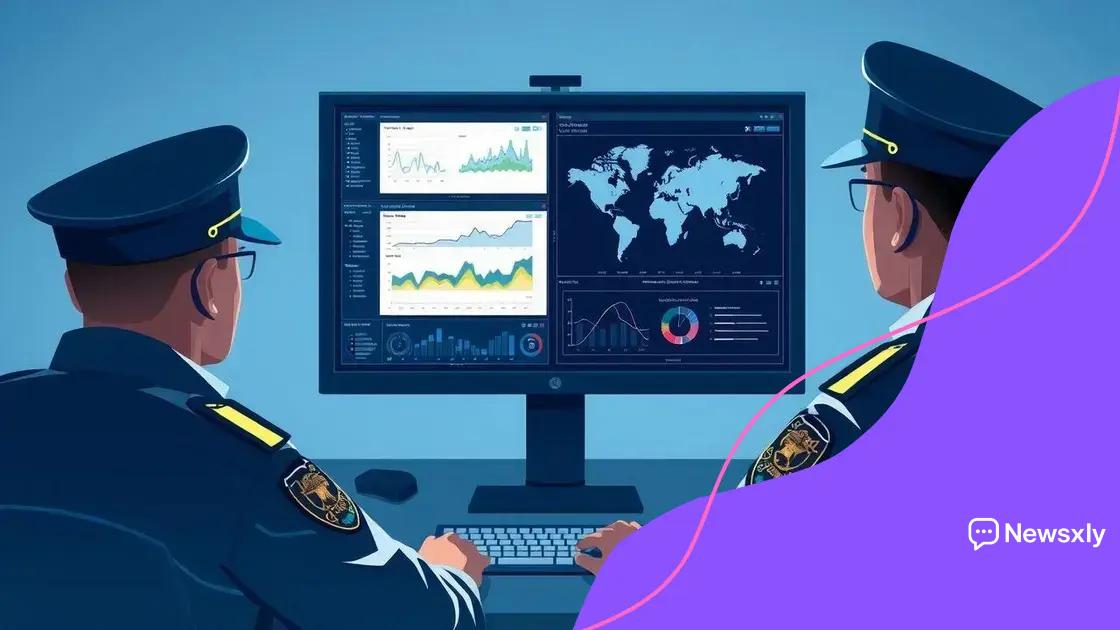The role of technology in law enforcement: enhancing safety

The role of technology in law enforcement involves the use of advanced tools like AI, biometrics, and data analysis to improve crime prevention, enhance investigations, and maintain community trust while addressing privacy and ethical concerns.
The role of technology in law enforcement has evolved dramatically, redefining the way police agencies operate. Technology enhances safety, streamlines workflows, and aids in complex investigations. Have you thought about how these advancements affect your community?
Impact of technology on crime prevention
The impact of technology on crime prevention is significant and continues to grow. Modern law enforcement agencies employ various technological tools to enhance their efforts and improve community safety. These advancements not only aid in reducing crime rates but also build trust between police and the communities they serve.
Surveillance Technologies
One of the key areas where technology has made strides is in surveillance. Cameras equipped with high-definition capabilities can monitor public spaces, aiding in real-time crime prevention. This presence often deters criminal activity.
- Real-time monitoring of public spaces
- High-definition video recording for evidence
- Community engagement through shared surveillance systems
Additionally, drones are increasingly being utilized by police departments. They provide aerial views of crime scenes, assist in search and rescue missions, and help track suspects during pursuits. Drones enhance the ability of law enforcement to respond quickly and effectively.
Data Analytics
Another crucial aspect is the use of data analytics. Law enforcement agencies analyze crime data to identify trends and hotspots. By understanding where and when crimes are likely to occur, they can allocate resources more effectively.
This proactive approach allows police to act before crimes happen, reducing fear in communities. Predictive policing uses algorithms to forecast potential criminal behavior based on historical data, which helps in planning interventions and focused patrols.
- Identifying crime patterns through data
- Allocating resources based on predictive models
- Enhancing community safety measures
Furthermore, technology facilitates communication within communities. Mobile apps and social media platforms allow residents to report suspicious activities and receive timely alerts. This community involvement strengthens the bond between citizens and law enforcement, fostering a safer environment for everyone.
Overall, the impact of technology on crime prevention is profound, showcasing how innovative tools can lead to safer and more informed neighborhoods. By embracing these advancements, law enforcement is not only better equipped to deter crime but also to build lasting relationships with the communities they protect.
Innovative tools and techniques in policing
Innovation plays a crucial role in law enforcement today. With the advent of new technologies, police agencies are equipped with innovative tools and techniques that enhance their effectiveness. These advancements not only improve operational efficiency but also foster greater transparency and accountability in policing.
Body-Worn Cameras
One of the most significant innovations is the adoption of body-worn cameras. These devices promote transparency by documenting police interactions with the public. Such recordings can serve as valuable evidence in investigations and help build trust within communities.
- Improved accountability for officers
- Clear evidence during disputes
- Enhanced community relations
Additionally, more police departments are beginning to leverage mobile apps that allow citizens to report crimes easily. These platforms encourage community engagement and facilitate quick communication between the public and the police.
Advanced Forensics
Innovative forensic techniques have also transformed crime scene investigations. New technologies, such as DNA analysis and digital forensics, provide law enforcement with advanced tools to solve cases with greater accuracy. 3D crime scene mapping enables officers to visualize crime scenes in detail, aiding investigations and court presentations.
Furthermore, artificial intelligence is being utilized to analyze data from various sources. This use of AI can help predict criminal behavior and enhance decision-making processes within police departments. Officers can focus on areas with a higher likelihood of crime based on these predictions, making their efforts more efficient.
- Enhanced accuracy in solving cases
- Speedy investigations through advanced data analysis
- Predictive policing to allocate resources effectively
As technology continues to evolve, so will the tools available to law enforcement. The integration of these innovative techniques not only empowers police forces but also leads to safer communities as they adapt to the challenges of modern policing.
Data analysis for better investigation outcomes

Data analysis for better investigation outcomes is transforming how law enforcement operates. By utilizing advanced analytical tools, police can gain insights that lead to more effective investigations. The ability to process large amounts of data quickly helps in identifying patterns and trends that might otherwise go unnoticed.
Harnessing Big Data
Many law enforcement agencies now leverage big data technology to enhance their investigative capabilities. This includes analyzing various sources of information such as crime reports, social media activity, and even geographical data. By combining these inputs, officers can identify crime hotspots and take proactive measures.
- Integrating multiple data sources for comprehensive analysis
- Identifying patterns that predict criminal behavior
- Improving response times to incidents based on data insights
Furthermore, data analysis helps in resource allocation. By analyzing historical crime data, police departments can deploy officers more efficiently, ensuring that high-risk areas receive the attention they need. This strategic approach not only deters crime but also fosters community trust.
Tools for Analysis
Several tools are available to assist law enforcement in data analysis. Software like geographic information systems (GIS) and crime mapping tools provide visual insights that reveal correlations between different types of crimes. These tools allow officers to visualize data trends over time and make informed decisions.
Additionally, officers use predictive analytics to forecast where crimes are likely to occur next. By understanding these probabilities, departments can implement preventive measures before incidents happen, creating safer communities.
- GIS for visual crime analysis
- Predictive models for crime forecasting
- Real-time dashboards for incident management
As data analysis continues to evolve, law enforcement will be better equipped to solve cases and serve communities more effectively. The integration of data analysis into everyday practices promises to enhance the overall effectiveness of police work.
Challenges of technology in law enforcement
The challenges of technology in law enforcement are increasingly prominent as police forces adopt new tools and systems. While technology offers numerous benefits, it also presents significant hurdles that agencies must overcome.
Privacy Concerns
One major challenge is the issue of privacy. Advanced surveillance technologies, such as facial recognition and drones, can raise concerns among the public. Many citizens worry about being constantly monitored, which can lead to distrust between communities and law enforcement agencies.
- Fear of intrusive surveillance
- Public backlash against technology use
- Legal implications surrounding data collection
Law enforcement must navigate these privacy issues carefully. Establishing clear guidelines and maintaining transparency can help alleviate public concerns.
Resource Limitations
Another challenge includes resource limitations. Implementing new technologies often requires significant funding and training. Many departments, especially smaller ones, may struggle to afford the latest tools or to train their personnel effectively.
Additionally, the rapid pace of technological change means that agencies must constantly adapt. Keeping up with new software and hardware can strain budgets and human resources.
- High costs of advanced technologies
- Need for ongoing training and development
- Difficulty in selecting appropriate solutions
Moreover, as technology evolves, cyber threats have emerged as a significant concern. Law enforcement agencies must safeguard their systems against hacking and data breaches. This challenge requires continuous investment in cybersecurity measures to protect sensitive information.
Ethical Considerations
Ethical considerations also play a vital role. The use of algorithms in policing can perpetuate biases if not monitored closely. Algorithms must be designed and refined to ensure they do not result in discriminatory practices.
This complexity highlights the need for ongoing evaluation of technology’s impact on communities. Open dialogue about how technology affects various groups can foster trust and collaboration.
As law enforcement embraces technology, these challenges must be addressed thoughtfully and strategically for effective implementation. Balancing innovation with community concerns is essential for building a safer society.
Future trends in law enforcement technology
The future trends in law enforcement technology promise to reshape how police forces operate and interact with their communities. Emerging technologies will enhance the capabilities of law enforcement, allowing them to address crime more efficiently than ever before.
Artificial Intelligence in Policing
Artificial intelligence (AI) is poised to play a significant role in future law enforcement. With AI, police can analyze data patterns rapidly and predict where crimes are most likely to occur. Predictive policing tools will help law enforcement agencies allocate resources more effectively.
- Use of algorithms to forecast criminal activity
- Streamlined investigation processes
- Enhanced training simulations for officers
Moreover, AI-driven tools can assist in analyzing video footage to identify suspects, making investigative processes quicker and more accurate. As these technologies advance, they will likely provide support in decision-making scenarios for officers on the field.
Integration of Biometrics
Another significant trend is the integration of biometric technologies such as facial recognition and fingerprint scanning. These tools will enhance the ability of law enforcement to identify individuals quickly and accurately, especially in crowded environments or during large public events.
With greater accuracy and efficiency, biometric systems can help prevent crime and identify suspects. However, this also raises ethical concerns related to privacy, making it essential for law enforcement to implement these technologies responsibly.
- Real-time identification of individuals
- Improved safety during public gatherings
- Accountability measures to protect privacy rights
Furthermore, advancements in mobile technology and communication systems will enhance the way police officers interact with their colleagues and communities. The use of mobile applications for reporting crimes and accessing information on-the-go will empower officers in their daily duties.
Cybersecurity Enhancements
As technology evolves, so do the cyber threats facing law enforcement. Future trends will likely focus on strengthening cybersecurity measures to protect sensitive data from breaches. Departments will invest in advanced protective systems to secure their information and maintain public trust.
With the rise of cybercrime, officers will also need training to handle and investigate digital offenses effectively. As these challenges grow, so will the need for ongoing education and resource allocation.
The combination of these trends will redefine law enforcement, making it more effective at preventing crime while promoting transparency and community engagement. Embracing change will be key to successfully navigating the future of policing.
In conclusion, the evolving landscape of law enforcement technology brings both exciting opportunities and significant challenges. Innovations like artificial intelligence, biometric tools, and enhanced data analysis are changing the way police interact with communities and combat crime. However, privacy concerns, resource limitations, and ethical questions need careful consideration. The future of policing will depend on how well law enforcement adapts to these trends while maintaining public trust and safety. Embracing technology wisely can lead to a more secure and cooperative environment.
FAQ – Common Questions About Technology in Law Enforcement
What role does artificial intelligence play in law enforcement?
Artificial intelligence helps police analyze data quickly, predict crime patterns, and improve decision-making in investigations.
How do biometric technologies enhance police work?
Biometric technologies like facial recognition and fingerprint scanning allow law enforcement to identify individuals accurately and swiftly.
What are the privacy concerns with surveillance technology?
Surveillance technology can lead to public worries about constant monitoring, potentially eroding trust between communities and the police.
How can law enforcement balance technology use and community trust?
Transparency in technology use and engaging with communities to address concerns are essential in maintaining trust while using advanced tools.





